Genre: RPG Developer: American Wave Publisher: Treco Players: 1 Released: 1992
Back in the day, Genesis owners felt a bit left out when it came to RPGs, with some saying the SNES got far more than Sega’s 16-bit machine did. But contrary to what was thought back then, there are a fair number of RPGs on the system outside of the three Phantasy Stars. Among those titles was a game called Sorcerer’s Kingdom, an RPG released by Treco in 1992. With Phantasy Star III having hit the year before, and the hype for Shining Force in full swing, Treco’s game slipped into the market, only to take a back seat when Climax’s strategy RPG hit a short time later. So was Sorcerer’s Kingdom unjustly shot down before its time, or was it mercifully put out of its misery? Read on.
Adventuring is in your blood. Your father, Adventurer Kanan, went forth to destroy an evil that was threatening the land, only to vanish during his quest. Left with many questions, you decide it’s time to leave your mother and your home village of Landale and follow in your father’s footsteps… to become an Adventurer. But what was the evil your father sought to battle? What happened to your father? Gaining the king’s permission, you set out to answer those questions and discover what wonders lay beyond the protective walls of Landale.
The visuals of this game are pretty varied in terms of quality. You’ll see buildings, trees, some of the NPCs and monsters, and even some grounds that range from decent, to quite good looking. Objects like the buildings in the village of Landale are loaded with details and look like someone really took time to craft them. However, as you explore, you’ll also see other monsters and NPCs that look very flat or are given odd colors, as well as areas of ground that are literally a single color with random pixels of a second color scattered sparsely around, giving them no real sense of being grass, dirt or what have you. It’s almost as if the graphics were split between three people… one more attentive and dedicated, another not quite into their work, and the third a complete slacker who didn’t care, resulting in a rather disjointed graphical look for the game.
The animation is about what you’d expect from an RPG of the era. Minimal frames for walking, attacking and all that, so don’t expect to be wowed. The designs of the monsters and NPCs are a mix of super deformed and realism, with fair amounts of shading and detail for the most part, along with somewhat funky proportions (bigger than normal heads, stubby arms, etc.). The character and monster designs themselves aren’t too bad, with some (like the kobolds, goblins and hydra boss) looking better than others (like the snow wolves, sand worms and Elrad). The spell effects fall into the same boat, with ice and the bigger fire and lightning spells looking all right, while others are less than impressive. All this boils down to the graphics not having a consistent quality, and it’s this visual back and forthing that leaves the graphics a small bit above average overall.
The sound in Sorcerer’s Kingdom is rougher than the graphics. The sound effects used in the game are pretty run of the mill, doing their job to give different actions different sounds. They don’t grow irritating, but they’re doing little more than filling what would have otherwise been a void in the game. So basically, nothing gained or lost really.
The music of the game is… average at best. Not because all the songs are on the same level, but because they’re all over the place in terms of quality, with more being on the iffy side than the good side. However, the one thing they share is that the instruments aren’t the best sounding things you’ll hear from a Genesis music engine. Half of them are rather tinny, and they just don’t sound all that nice… especially on high notes. As for the songs themselves, they vary from highly repetitive and grating (“Adventurer’s Inn,” “Pure Drop,” “Holy Place” and “Snow Labyrinth”), to slower, better and more mood setting (“Pleasure Heart” and “Separate Ways”), to battle-centric and a little better still (“D and D,” “No Fear, No Waver!” or “Gloria”). The quality of the compositions is just as scattered as the song types, making for a soundtrack that simply doesn’t come together to make for enjoyable listening. It has its moments, but more often than not the music is just not a high point.
The gameplay for this game is a mixture of genres really. On the RPG front, you have what would be expected. Hit points for health, magic points for the spell users, spells are learned as you go along, and so forth. You journey on an overworld map to get from place to place, and as you make your way through the game, you’ll encounter new characters that eventually join you on your quest. Armor and weapon upgrades can be purchased and found for everyone, as can spells and potions. You have stats like attack, defense, and all that to build up, and these change as you gain both levels and better equipment. Experience is gotten from killing the various monsters that roam the countryside, with gold and other goodies being found in chests and fallen enemies.
You can see the enemies in this game moving around, allowing you to try and avoid them if you wish (no random encounters here), or completely clear out an area. If you get too weak from fighting those monsters, you can stay at an inn to recover and save, and for a change, the cost of doesn’t continually go up with each new village you find (it’s ten gold at each inn, but you can stay free at your mother’s home in Landale).There’s a rather handy map you can use to warp to lands you’ve already visited, and lastly, when you do battle, it’ll be a bit different than what you’re used to. It’s still turn-based, but you only use one character at a time, and the enemy counter attacks after each character. So it’s not like other RPGs where all four party members and the enemy gets one attack each per turn.
On the strategy front, there are a few variables and such that affect the different traits of your characters. For example, when you fight, you have what are called “Range” points, meaning how many spaces you can move per turn during battle (the brighter areas when you chose “move” show were you can reach). These points are affected by your experience level, and by the type of armor/weapon you’re using. This means that you have to weigh the options of getting that new armor, as it may boost your defense rating, but you lose three Range points wearing it. You can also move all around the battle screen, meaning you can run to other enemies for fighting, or send a near-death character to a corner so they’re not attacked (physically at least).
An interesting twist to the battles comes with how your character doesn’t do just one swing and there’s your damage. Rather, they’ll use multiple swings based on “Attack Pts.” This number is how many swings your character will perform when they attack, with each swing having about an equal chance to hit or miss. And like the Range points, it’s affected by your experience and equipment. Plus, which side of the enemy you’re on partially dictates how many times you’ll hit them, how many times they’ll attack/hit you, and even how much of a counter attack you get after they’ve attacked (this secondary attack grows at you gain experience). As an example, I was able to do better in battles attacking the enemies from behind instead of face to face. It may have simply been dumb luck, but that’s what happened quite regularly.
And if that isn’t enough strategy for you, your characters level up not all at once, but rather one at a time. By this I mean if you only use a character in every battle (which is possible), only he/she will steadily go up levels. So to make your other characters gain levels, you have to use them in battle. Otherwise, you’ll wind up with one really powerful character and three wusses tagging along behind him/her. All this makes for battles that are a lot more involving and challenging, while it also leads to more grinding. But hey, 16-bit RPGs were all about the grind more often than not, right?
So we’ve got an RPG that mixes in a healthy dose of strategy to the usual RPG conventions. What does it do wrong? Again, the music needs help. Even if the compositions are all right, the instruments more often than not, aren’t. I realize Treco wasn’t the most musically inclined group, but they did better work with some of their other games. And of course, the graphics need a steadier level of quality. If the entire game was done with the same care as the buildings in Landale or some of the trees, this would be a rather nice looking game. Instead, it’s a mish-mash of good, flat, and in-between. Beyond these main areas, the controls are fine, and there aren’t really any major gameplay or control issues.
On the minor side of things, the story is pretty bland. Boy follows father, seeks out great evil to save the land, etc.. Nothing new to be found, though for a change, they ditched the “I used to be good but now I’m evil” bit that seemed almost ready to happen. Another area of annoyance, was how fast the NPCs move (especially children). These people must be jacked up on something, as each burst of movement is roughly twice as fast as yours. The end result is them getting repeatedly in your way when you’re trying to get around them, forcing you to talk to them again and again because you touched them. One additional issue that might catch some people off guard, is how the game lets you know that a magic user can’t use their magic if they equip a specific weapon or piece of armor. Basically, pay attention to the magic points along the top-right as you’re shopping with a given character. If that item cancels their magic, it’ll let you know. Many items tell you this in the short description window as well, but not all of them do. So heads up on that.
On a final note, the way the game handles leveling is both interesting and a pain. It’s great to see someone try something different that actually does make sense. After all, why would the monster stand there and only attack once, when it was attacked four times by different people? Wouldn’t it fight back each time? But even so, it does tend to drag the game out as you try to level up all your characters so that they can aid you in battle. Although to be honest, your main character can pretty much beat any monsters you encounter with enough leveling, so you could let all your secondary characters die and just use the main one of your choice if you wanted to. Whether this is good or bad will depend on how you view it, but keep in mind that you’ll need to revive the others at the church in Landale (for free even!) so you can get promoted by the king.
So what can be said about Sorcerer’s Kingdom? It’s not the best, nor the worst RPG on the Genesis. The visuals and sound are littered with highs and lows, with so-so music that’s disappointing half the time, and graphics that are all over the board in quality. It’s not helped by the rather standard storyline either, but the game gets a boost thanks to gameplay that’s solid with some more involving variations used to spice up the battles. Yeah, the mechanics for leveling up will garner some criticism to be sure, but it does take a different route from the norm of the day that some may find refreshing like I did. So while this game likely won’t become a classic in the eyes of many, it’s an RPG that, despite some noticeable short comings, is above average when you add everything up and a decent game to sit down with if you’ve played the Phantasy Star entries to death.
SCORE: 6 out of 10

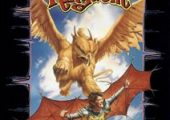
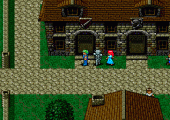
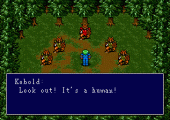
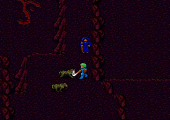
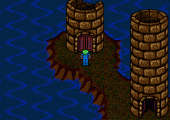
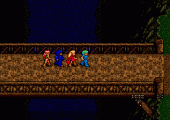
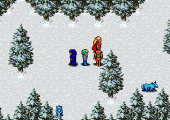
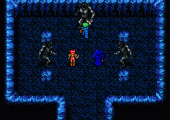
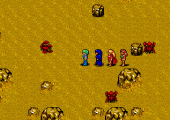
I agree with pretty much the entire review. It’s an average RPG that has its moments and some things are annoying about it. I say it’s worth a playthrough if you are an RPG fan.
The game was a mixed bag but I didn’t mind it at all. I ended up really getting into it and enjoying it a lot more than I thought I would when I first started it up.
Took me ages to figure out what it was called as I only ever hired it and all I could remember before now was a main hero with green hair, a guy in a blue robe and a blonde elf babe. It wasn’t much to go by but thankfully with the Mega Drive not having the largest RPG library out there it was only a matter of time before I would track this down.